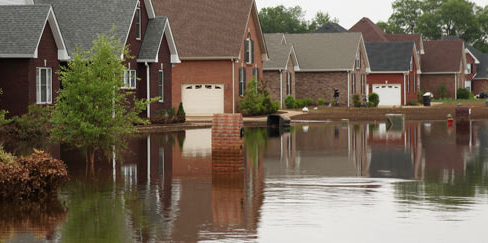In light of the substantial rainfall that Georgians experienced this summer, it’s hardly surprising to come across news reports detailing flooding, complete with images of swollen creeks and submerged houses. What might catch you off guard, though, is the revelation that a significant portion of this year’s severe flooding in Georgia occurred in the mountainous North Georgia region. This area, which doesn’t fit the conventional mold of a flat, flood-prone region, witnessed a surprising level of flooding.
This situation underscores a vital point – flooding isn’t confined to specific geographical features. It can strike anywhere, affecting anyone, at any time.
The Prevalence and Cost of Flooding
Flooding, in fact, ranks as the most common and financially burdensome natural disaster in the United States. Unfortunately, many homeowners only come to realize, often too late, that their standard homeowner’s insurance policy does not cover the damages caused by floods. Instead, safeguarding against such perils necessitates acquiring a specialized “Flood Insurance” policy.
Navigating the National Flood Insurance Program (NFIP) through RCBAP
Flood insurance can be readily obtained through the National Flood Insurance Program (NFIP), an initiative overseen by the Federal Insurance and Mitigation Administration under FEMA. This form of insurance extends coverage to both structural damage and content loss. For community associations with structures, two distinct policies come into play: the standard flood policy for detached single-family homes and the Residential Condominium Building Association Property (RCBAP) policy for condominium units.
Focus on RCBAP Policy: Protection for Condominium Units
Zooming in on the RCBAP flood policy, its purpose is to safeguard the interests of condominium unit owners. It offers coverage for structural harm caused by flooding, a scenario defined as a general or temporary state of partial or complete inundation of normally dry land or multiple properties. This encompasses overflow from inland or tidal waters, along with the rapid accumulation or runoff of surface waters from any source, including mudflow. Notably, the coverage ceiling is $250,000 per unit in a multi-unit building.
Considering Contents Coverage and Its Limit
However, it’s essential to note that a building-oriented policy does not extend to cover the contents within the unit. In such cases, homeowners are required to procure a separate policy. The coverage cap for contents under this policy variant is set at $100,000.
Understanding the Financial Implications and Zone Classification
The cost and availability of an RCBAP flood policy hinge on the property’s location and its classification within flood zones determined by NFIP’s mapping of flood plains. These zones correspond to the frequency of flooding incidents.
Decoding the “100 Year Flood” Concept
It’s worth dispelling a common misconception surrounding the term “100 year flood.” This term does not signify a flood that transpires once in a century. Instead, if a property falls within a 100 year floodplain, it means there’s a 1% annual probability of flooding.
Vulnerability Beyond High-Risk Zones
Recent instances of flooding in North Georgia’s mountainous terrain serve as a reminder that properties not traditionally considered within flood-prone areas can still be susceptible. According to NFIP, more than 20% of claims filed and a third of disaster assistance for flooding come from areas that aren’t designated as high-risk zones.
Contemplating RCBAP Flood Policy: A Wise Choice
Even if your property isn’t positioned in a high-risk area, proximity to water bodies like creeks, drainage ditches, or detention ponds could leave you exposed to flooding. Investing in an RCBAP flood policy is often a prudent decision, particularly given the relatively affordable cost for low-risk areas. On average, a yearly flood insurance premium stands at around $640.00.
Accessing Coverage
Acquiring an RCBAP flood policy is achievable through state-licensed property and casualty insurance agents, the same professionals you might consult for other property insurance needs. Alternatively, visit www.floodsmart.gov to locate an agent and embark on securing the necessary protection for your condominium unit.


